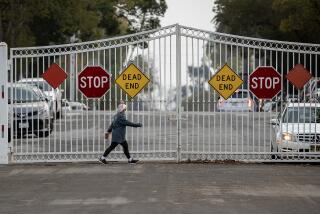L.A. neighborhoods, you’re on the map
Nevermind where we’re going. Question is: Where are we now?
“We’re in Woodland Hills,” said Anthony Tholberg as he stood outside his home late last week and mulled over that question.
Tholberg, 23, grew up in the mid-century modern house in the 19800 block of Friar Street. No wonder he was puzzled when he was handed a copy of a new map that labeled his 54-home enclave as being in the community of Winnetka.
The Los Angeles Times is unveiling the new map of neighborhoods today on its website at www.latimes.com/mappingla. Years in the making, it is designed to be a tool that will allow reporters and editors to be consistent when describing neighborhoods in news stories in a city that sometimes seems to change the names like most people change socks.
Dorothy Parker famously said Los Angeles was “72 suburbs in search of a city,” so it’s not surprising that residents take their neighborhood names so seriously. Those designations are part tradition and history -- but also part economic and political. Many residents see big differences in property value if you live in tony Hancock Park as opposed to more working-class Mid-City.
In the Valley, there’s a grand tradition of seceding from traditional neighborhoods. Parts of gritty Van Nuys have become Valley Glen and Lake Balboa, while a portion of Canoga Park re-christened itself West Hills.
For its new map, The Times listed Winnetka, not Woodland Hills, as Tholberg’s community. The dividing line followed Topham Street and the new Orange Line busway where they bear south from Woodland Hills’ long-standing northern boundary, Victory Boulevard.
“We’re going to keep calling ourselves Woodland Hills here,” predicted the college student. “Our mail is addressed Woodland Hills and that’s what everybody’s always called it. We’ve always considered the intersection of Victory and Corbin as where Woodland Hills, Tarzana, Reseda and Canoga Park meet.”
The “Canoga Park” that Tholberg referred to is labeled Winnetka too on The Times’ map.
Fortunately, those who disagree with the map have a chance to persuade the newspaper’s mapmakers to reconsider. Readers can use the interactive website to redraw any section of the map they feel is incorrect and submit the alteration for editors’ consideration. And editors may be busy.
In Highland Park, the map uses Avenue 50 as the dividing line between that community and next-door Mount Washington. That may have plopped hundreds of homes and businesses into Mount Washington by mistake, according to locals.
“I think a lot of people in Mount Washington will be upset by this. It’s going to hurt their real estate values,” said David Robles, a 34-year-old math coach at Aldama Elementary School. The Times map says his campus is in Mount Washington.
“We’re in Highland Park,” he said. “A lot of people around here would love to be in Mount Washington, but they’re not.”
Robles and others at the school said the boundary should be at the base of the hill that gives Mount Washington its name.
Across town, salesman John Kim stood outside his apartment on Manhattan Place a few steps from Melrose Avenue and shook his head at the newspaper’s map. It said he lives in Hancock Park.
“This should be Koreatown,” said Kim, a 10-year resident of the area. “Hancock Park is a nice area. My landlord jokes this is the ‘Koreatown Ghetto.’ To me, Hancock Park doesn’t start until past Wilcox. Koreatown should go west to Arlington.”
Up the street, carwash cashier Leyda Pena suggested that the neighborhood should be considered Hollywood instead of Hancock Park. “The map shows Hollywood is on the other side of the street,” she said, pointing to the north side of Melrose. “We should be too.”
Pena said she lives in South-Central Los Angeles, an area The Times’ map initially didn’t recognize as a neighborhood. Instead, it broke South Los Angeles into places such as Exposition Park, Leimert Park, West Vernon, Harvard Park, Green Meadows and Vermont Vista.
Why is neighborhood naming so difficult? The city of Los Angeles has posted hundreds of blue street signs denoting scores of neighborhoods -- from Little Ethiopia to Little Tokyo to Little Armenia. But the city has never drawn the official boundaries of each district.
Los Angeles activist Brady Westwater, who in the past has been a vocal critic of what he has considered the misnaming of neighborhoods in news stories, acknowledged that nailing down names that everyone will agree on will be difficult.
“The first lynch mob is going to be coming down the hill down Beverly Glen Boulevard,” he predicted as he studied the preliminary map. The area the newspaper is calling Beverly Glen includes upscale areas north of Beverly Hills that use a Beverly Hills mailing address.
“You’ll also get some blowback from Van Nuys -- it’s been chopped up. For some reason Pico-Union is being pushed west. No way west of Hoover can be considered Pico-Union.”
Westwood historian Greg Fischer, who since the late 1980s has researched original Los Angeles subdivision tract names and sparked a campaign to memorialize them around town with officials city signs, noted that the neighborhood of Little Tokyo is missing from The Times’ map.
“If Chinatown is there, Little Tokyo would certainly seem to have a place,” Fischer said. “Rancho Park is not really a good name. It’s actually ‘South Westwood.’ Beverly Glen is very suspect -- ‘Beverly Crest’ would probably be better.”
There will be space for recognition of original housing tract names in a “sub-neighborhood” list that will be attached to each of the 87 communities the Times’ map recognizes. Eventually, the map may become an electronic entryway to detailed neighborhood information -- crime statistics, census information, economic data and links to Times stories, said Times Database Editor Doug Smith, the map project’s coordinator.
Smith, a veteran Times reporter, said the map was compiled with information drawn from such references as a mid-1990s mayor’s office map, a 2001 Times map that plotted potholes in the city, the Thomas Guide, U.S. census tracts and Times staffers’ personal experience and knowledge.
“To be honest, it’s more seat-of-the-pants than scientific,” Smith said. “We didn’t go to original Spanish land grant maps. The authority is the collective wisdom of the L.A. Times.”
California Editor David Lauter, who pushed to give readers an opportunity to review and comment on the project, urged that the map’s basic communities be limited to 100. He said “sub-neighborhoods” could list historic or ceremonial names found in the city.
There was lengthy debate over many districts. “Mount Olympus” or “Hollywood Hills West?” Where does Porter Ranch end and Chatsworth begin?
Web designer Ben Welsh wondered whether a small section of the Los Feliz area should be singled out as a neighborhood that locals know as Franklin Hills. Cautioned researcher Maloy Moore: “I’ve met people who are very adamant that they live in Franklin Hills, not Los Feliz.”
Smith said adjustments will continue to be made to the map when readers and users submit convincing arguments and as demographics and situations change.
Even as Smith spoke, his colleagues were incorporating some of Westwater’s suggestions and rethinking such decisions as the use of the South-Central Los Angeles name.
“This will be a work in progress,” Smith said.
More to Read
Start your day right
Sign up for Essential California for news, features and recommendations from the L.A. Times and beyond in your inbox six days a week.
You may occasionally receive promotional content from the Los Angeles Times.







